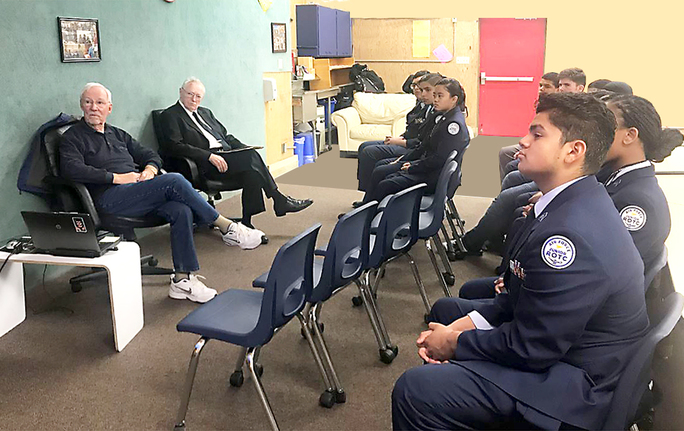Our little village is somewhat isolated in far north Fairfield, but many of us have ties to our host town. The PVE – Air Force Junior ROTC Interface Committee is one such tie. Established to foster the intergenerational relationship between residents of Paradise Valley Estates and the Fairfield High School Air Force JROTC cadets, the committee facilitates community contact.
The Air Force JROTC program seeks to educate and train high school cadets in citizenship and life skills; promote community service; instill a sense of responsibility; develop character, leadership and self-discipline through education; and provide instruction in air and space fundamentals and the Air Force’s core values of integrity first, service before self and excellence in all we do.
The program’s instructor, Lt. Colonel Dave Avery, recently asked committee chair Chuck Smith if we had any residents with experience in space-related endeavors as this term’s AFJROTC curriculum included a block called Space: The Next Frontier.
It turns out we do. Five residents recently sat in on an AFJROTC class and spoke of their work on space-related projects, giving the cadets priceless insight into U.S. space programs and what it was like to define and solve issues that had, until that time, not existed.
Bill Getz spoke of the genesis of the U.S. space program, spurred by the Germans’ V-2 development and Soviet advances, both in intercontinental missiles and atomic warheads. Bill is a true space pioneer, a member of The Schoolhouse Gang who started the nation’s first ballistic missiles and space programs in an abandoned parochial school house in Englewood, California in 1944.
Bob Epperson followed Bill, speaking of the challenges of dealing with the many hazardous materials used in space flight. He gave the cadets insight into a 1970 Titan accident in Arkansas and into the problems associated with handling the space shuttle’s 21 toxic waste streams, then shared a story about a shuttle launch problem caused by a simple human error.
Phil Fisher, a National Air and Space Museum Wall of Honor recipient, showed pictures of rocket and satellite hardware and the results of a successful 1960s NASA funded effort at the Lockheed Missiles and Space Co. to discover and locate previously unobserved night sky X-ray sources.
John Weigelt, a 25-year NASA contractor, discussed his work at NASA Neil A. Armstrong Flight Research Center. He showed photos and videos of the shuttle landing and of several aeronautical programs he worked on, including the X-43 hypersonic aircraft and the Automatic Ground-Collision Avoidance System.
Wolf Schaechter discussed his three jobs that focused on getting to space — the Martin Company where Titan missiles were built, Thiokol where the space shuttle motor was produced, and a mid-60s stint at the joint AEC-NSA Space Nuclear Propulsion Office tasked with developing a nuclear rocket for interplanetary space travel.
The cadets loved the sessions and the chance to hear our guys’ stories first-hand.




